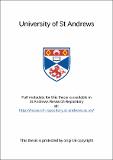Files in this item
The quantitative genetics of pheromone blend in 'Drosophila'
Item metadata
| dc.contributor.author | Adamson, Carrie | en |
| dc.coverage.spatial | 53p | en |
| dc.date.accessioned | 2021-04-08T08:59:35Z | |
| dc.date.available | 2021-04-08T08:59:35Z | |
| dc.date.issued | 2001 | |
| dc.identifier.uri | https://hdl.handle.net/10023/21952 | |
| dc.description.abstract | Drosophila simulans and D. sechellia are sibling species of the melanogaster group and are so closely related that crosses between them produce fertile female offspring. Recognition of a potential mate in Drosophila depends on many cues including olfactory and auditory stimulation by female pheromones and male courtship song respectively. Once recognition of a potential mate has occurred then behavioural signals indicate acceptance or rejection. Female pheromones play an important role in conspecific mating and interspecific differences appear to be due to a few loci, mainly on the third chromosome. These were identified using only morphological marker loci in the past. This study investigates the location of loci contributing to differences in pheromone blend using QTL analysis of flies produced by backcrossing hybrid females to D. simulans males. The more modern method of using molecular markers will be used for this analysis. The scored markers are analysed using the QTL cartographer program to determine the level of association of the regions between pairs of markers to the trait. | en |
| dc.language.iso | en | en |
| dc.publisher | University of St Andrews | en |
| dc.subject.lcc | QL537.D76A3 | |
| dc.subject.lcsh | Drosophila melanogaster--Behavior | en |
| dc.subject.lcsh | Drosophila melanogaster--Genetics | en |
| dc.title | The quantitative genetics of pheromone blend in 'Drosophila' | en |
| dc.type | Thesis | en |
| dc.type.qualificationlevel | Doctoral | en |
| dc.type.qualificationname | MPhil Master of Philosophy | en |
| dc.publisher.institution | The University of St Andrews | en |
This item appears in the following Collection(s)
Items in the St Andrews Research Repository are protected by copyright, with all rights reserved, unless otherwise indicated.

